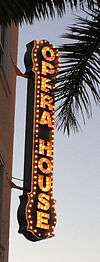Sarasota Opera House
|
Edwards Theatre | |
|
Renovations to the exterior and interior in 2007/08 resulted in major modifications, but the exterior was not fully finished as of late March 2008 | |
  | |
| Location | Sarasota, Florida |
|---|---|
| Coordinates | 27°20′12″N 82°32′38″W / 27.33667°N 82.54389°WCoordinates: 27°20′12″N 82°32′38″W / 27.33667°N 82.54389°W |
| MPS | Sarasota MRA |
| NRHP Reference # | 84003835[1] |
| Added to NRHP | March 22, 1984 |
The Sarasota Opera House (originally the Edwards Theatre) [2] is an historic theatre, now opera house, located at 61 North Pineapple Avenue in Sarasota, Florida. The vision of a local man and the first mayor of the town, A. B. Edwards. It originally opened on April 10, 1926 with an elaborate three-story entrance containing "eight shops on the ground floor, 12 offices on the second floor, and 12 furnished apartments on the third,[3] while the theatre's auditorium contained an orchestral pipe organ. As noted on the Sarasota Opera's website, the Sarasota Herald Tribune hailed Edwards for "having admitted Sarasota into a fairyland of costly decoration, rich furnishings and never to be forgotten artistry."[3]
The building was designed by Roy A. Benjamin in the Mediterranean Revival Style Architecture[4] and constructed by the GA Miller Construction Company.
The theatre is now the home of the Sarasota Opera Association, Inc., which owns the building. The Association is the parent body which runs the Sarasota Opera. The house now seats 1,119.
Early history
In the 1920s, it quickly became a popular entertainment venue with major performers of the day, such as Will Rogers (in 1927) and the Ziegfeld Follies (1928), and Elvis Presley (1956), appearing there. Also, it became a movie theatre when it presented the world premiere of Cecil B. DeMille's The Greatest Show on Earth (which had been filmed in Sarasota) attended by its stars Charlton Heston and Dorothy Lamour.
Over the years, managements changed as did the name of the theatre: in December 1936 it became The Florida Theatre [5] while, in the same year, a hurricane damaged the Robert-Morton pipe organ. Various attempts to modernize removed most of its original Art Deco. It became a full-time movie theater, but, finally, in 1973, it closed.
Renovations, 1979
However, opera was beginning to be presented in Sarasota by a non-profit organization, the Asolo Opera Guild, which presented small-scale operas from out of town in the 320-seat Asolo Theater. By 1974, they had begun to produce their own operas. In 1979, the Guild bought the old Edwards Theatre for $150,000. Needing major renovations to restore the house and to accommodate the demands of opera, the Association began renovations in 1982, the result of which was that the new Sarasota Opera House appeared on the National Register of Historic Places in March, 1984.
Renovations, 2007-8


However, opera was beginning to be presented in Sarasota by a non-profit organization, the Asolo Opera Guild, which presented small-scale operas from out of town in the 320-seat Asolo Theater. By 1974, they had begun to produce their own operas. In 1979, the Guild bought the old Edwards Theatre for $150,000. Needing major renovations to restore the house and to accommodate the demands of opera, the Association began renovations in 1982, the result of which was that the new Sarasota Opera House appeared on the National Register of Historic Places in March, 1984. Further renovations between the end of the 2007 season and the 1 March 2008 opening of the 2008 season have led to a significantly-enhanced opera theatre.[6]
The $20 million renovations included gutting the auditorium, which resulted in a newly configured seating plan, expansion of the public areas and Opera Club on the second level, the opening up of the 3-story atrium to expose a newly installed skylight system which had existed in the 1926 building, but which had been covered by a ceiling and a chandelier used in the film, Gone with the Wind. In 2008, the Sarasota Opera reopened with Verdi's Rigoletto. Seating was expanded to approximately 1,200. After the 2009-2010 season, some seats along the far sides were taken out and replaced with aisles on either end of the theater leaving 1,119 seats.
See also
References
Notes
- ↑ National Park Service (2010-07-09). "National Register Information System". National Register of Historic Places. National Park Service.
- ↑ "Vintage Sarasota: Edwards Theatre", 1926 photograph in Sarasota Magazine, May 15, 2013 online at sarasotamagazine.com
- 1 2 "Theater History" with photograph on sarasotaopera.org
- ↑ Edwards Theatre, Sarasota History Alive! on sarasotahistoryalive.com
- ↑ Photograph of the theatre as The Florida Theatre on cinematreasures.org
- ↑ Sarasota Opera House: an account of the renovation with interior photograph on almond-architects.com
Sources
- The Edwards Theatre on sarasotahistoryalive.com.
- Information and photos of the opera house on cinematreasures.org
- LaHurd, Jeff, Sarasota: A Sentimental Journey in Vintage Images, History Press, 2004. ISBN 9781596290242 on books.Google.com
- "Vintage Sarasota: Edwards Theatre", Sarasota Magazine, May 15, 2013 online at sarasotamagazine.com.
External links
- Sarasota County listings at National Register of Historic Places
- Florida's Office of Cultural and Historical Programs
- Sarasota Opera website - History
